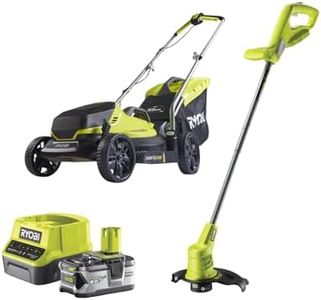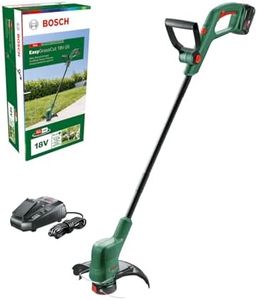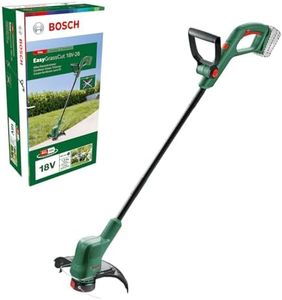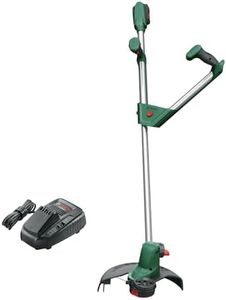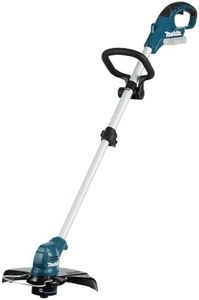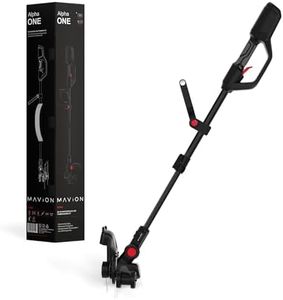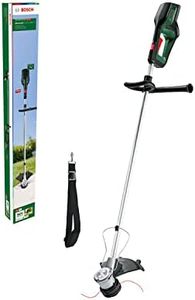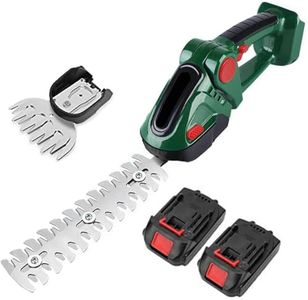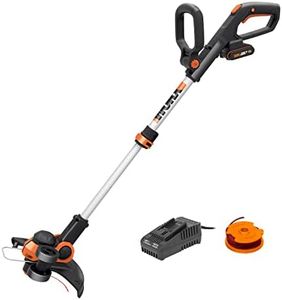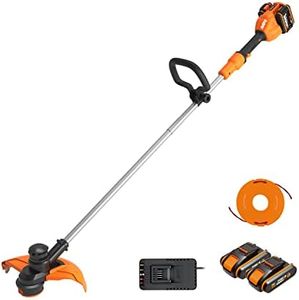We Use CookiesWe use cookies to enhance the security, performance,
functionality and for analytical and promotional activities. By continuing to browse this site you
are agreeing to our privacy policy
10 Best Cordless Grass Trimmers
From leading brands and best sellers available on the web.By clicking on a link to a third party's website, log data is shared with that third party.
Buying Guide for the Best Cordless Grass Trimmers
Choosing the right cordless grass trimmer can make your lawn and garden maintenance much easier and more efficient. Grass trimmers are designed to help you tidy up edges, trim around obstacles, and reach spots your lawnmower can’t. To find a trimmer that’s best suited for you, it’s important to consider factors beyond just the basic power or look at the tool—think about how you'll use it, the size of your yard, and how comfortable the tool is to handle over time.Battery Voltage and CapacityBattery voltage and capacity are key specs that determine how powerful your trimmer will be and how long it will run before needing a recharge. Voltage is often shown in volts (V), and higher numbers generally mean more power for tougher weeds and thicker grass. Battery capacity, measured in amp-hours (Ah), tells you how long you can use the tool per charge. Lower voltage (18-20V) trimmers are great for light, occasional yard work, while higher voltage (36V and above) models can handle bigger spaces and thicker growth. If you plan to do longer trimming sessions or have a larger yard, aim for a higher capacity battery to avoid too many recharges.
Cutting WidthThe cutting width is the diameter of the area the trimmer can cut in one pass, usually measured in centimeters or inches. Wider cutting widths (about 12-14 inches or more) let you finish the job faster, covering more ground each time. However, a smaller cutting width (8-12 inches) can mean better control and easier handling in tight spaces or around delicate plants. If your yard has many narrow or hard-to-reach areas, a smaller width could be more practical, whereas larger open areas might benefit from a wider one.
Weight and ErgonomicsWeight and ergonomics play a huge role in how comfortable and easy it is to use the trimmer. Lighter models (around 5-7 pounds) are much easier to handle for longer periods, especially if you have lots of edges or tricky spots to trim. Heavier models may have more power but can get tiring if you need to use them for extended sessions. Ergonomic features like adjustable handles or telescopic shafts also help you customize the tool to your height and grip, reducing back strain and improving maneuverability. Think about your physical comfort and how long you'll typically be trimming when considering weight and ergonomics.
Line Feed SystemThe line feed system refers to how the trimmer releases more cutting line when the old one wears down. Common systems include manual feed, bump feed (where you tap the head on the ground), and automatic feed. Manual systems require stopping and adjusting the line by hand—good for simple, occasional jobs but less convenient for bigger areas. Bump feed is a popular middle ground, allowing you to quickly extend the line during use. Automatic feed is the easiest, offering continuous trimming, but may sometimes be less reliable. If you want as little interruption as possible, look for bump or automatic feed systems.
Adjustable FeaturesAdjustable features, such as rotating heads, adjustable shaft lengths, or tilting handles, make the trimmer more versatile and comfortable to use for different trimming angles and user heights. A rotating or pivoting head, for example, makes it easier to switch between trimming and edging, while an adjustable shaft ensures you can use the tool without bending awkwardly. If you’re planning to use your trimmer for a variety of tasks or multiple people will use it, these adjustable features can really boost convenience.
Noise LevelNoise level indicates how loud the tool will be in use, which can affect your comfort and your relationship with neighbors. Cordless grass trimmers are already quieter than gas-powered ones, but some still produce a noticeable buzz. If you live in a quiet neighborhood or prefer early morning or late evening yardwork, checking for quieter models or brands that advertise low-noise operation can be helpful. Remember that noise can also add to fatigue during extended use.
